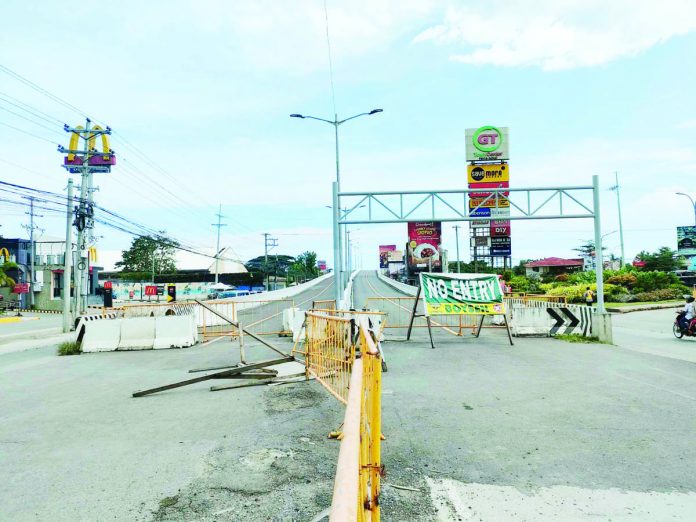
ILOILO City – Rectifications on the defective P680-million Ungka flyover in Barangay Ungka II, Pavia, Iloilo will be implemented as soon as the budget for the repair becomes available, according to the Department of Public Works and Highways (DPWH).
Secretary Manuel Bonoan said the agency included in its proposed 2024 budget an allocation of about P200 million for the poorly constructed flyover.
On Thursday morning, Sept. 7, the DPWH, led by Bonoan, presented its proposed P821.1-billion budget for fiscal year 2024 before the House Committee on Appropriations.
During the budget hearing, Kabataan Party-list’s Rep. Raoul Manuel asked Bonoan whether or not the Ungka flyover rectification would receive funds from the department.
Bonoan responded: “Your honor, yes, we have included partly an allocation for the rectification of the flyover so that it can be used as soon as possible.”
When asked how much the allocation was, the DPWH Secretary said, “Initially, your honor, we have allocated, I think, more or less, P200 million.”
The Ungka flyover’s repair would need at least P250 million, according to Adam Abinales, structural engineer of Abinales Associates Engineers + Consultants.
The DPWH-hired third-party consulting firm conducted a geotechnical investigation on the flyover’s vertical displacement on piers 4, 5 and 6.
Not escaping the Kabataan party-list representative’s scrutiny, Bonoan was also asked about the efforts to determine who would be responsible for such a costly mistake.
“Mr. Chair, napakalaking gastos po ito sa repair lalo na at ang original cost ng flyover is P680 million, very costly po ‘yong repair kaya kung i-sho-shoulder naman ito nga ating kababayan sobrang inhustiya na po ito habang hindi natin nakita ‘yong sincerity na mapanagot ‘yong talaga mga sa likod ng proyekto,” said Manuel.
Bonoan again reiterated that the DPWH, while investigating for accountability, is currently keen on finding a solution so that the idle infrastructure can be used as soon as possible.
“While we are investigating how this happened, I would like to make the facility usable at the earliest possible time, and this is what we are looking at, what rectification needs to be done immediately at this point,” said Bonoan.
Manuel further inquired about the pre-project construction soil test, in which Bonoan explained that, based on the DPWH record, there was indeed a soil test conducted prior.
The soil test was carried out by the United Technology Consolidated Partnership (UTCP), a third-party consulting firm hired by the DPWH central office.
Manuel wondered about the result of the soil test and how did that figure in the design of the flyover.
In March this year, DPWH-6 hired Abinales Associates Engineers + Consultants for P13,480,880 to conduct a geotechnical investigation on the flyover. It found out that the soil was still soft even at 50 meters deep.
Manuel questioned why DPWH agreed to have the piers less than 30 meters deep, far from the stable solid soil layers.
Geotechnical investigation, according to trenchlesspedia.com, implies the use of different methods to determine the physical properties of soil and rock below the surface of the earth at a proposed installation site. It helps engineers decide the type of tools required to dig through the site in the most economical manner.
It also assesses the potential environmental impact that a project may have on a particular area.
Aside from determining the cause of the vertical displacement of settlement in piers 4, 5 and 6 (if counting the posts from Christ the King Memorial Park), the firm was also tasked with formulating the appropriate intervention for the defect.
Three recommended schemes of rectification were:
* Scheme 1: Provide additional bored piles.
Pros – Group pile capacity will significantly increase to sustain the required demand capacity at the pier base.
Cons – To drive the additional bored piles, affected existing prestressed concrete (PSC) girders on coping beams will be removed and replaced, if necessary, since large equipment shall be used for drilling and driving bored piles.
* Scheme 2: Provide a portal frame to support the existing PSC girders.
Cons – To drive the new bored piles to construct and support the portal frame, right-of-way acquisition will be a great challenge; the portal frame will ignore the effect of the existing piers to support the PSC girders already installed.
* Scheme 3: Underpinning the existing piers and abutments, including existing bored piles, by intense jet grouting.
Pros – Underpinning will only require at least three meters of vertical clearance; therefore, existing PSC girders may not need to be removed and replaced.
Cons – Quantities of staged grouting will depend on the soil condition and stratum to develop the required pile capacity to sustain the demand load capacity at each pier/abutment. This scheme should be handled by the specialty contractor for intensive jet grouting, which is a proprietary specialty work. Verification is required by performing a static load test of the jet grouting.
Abinales recommended Scheme 1, or providing additional bored piles, as more feasible./PN



